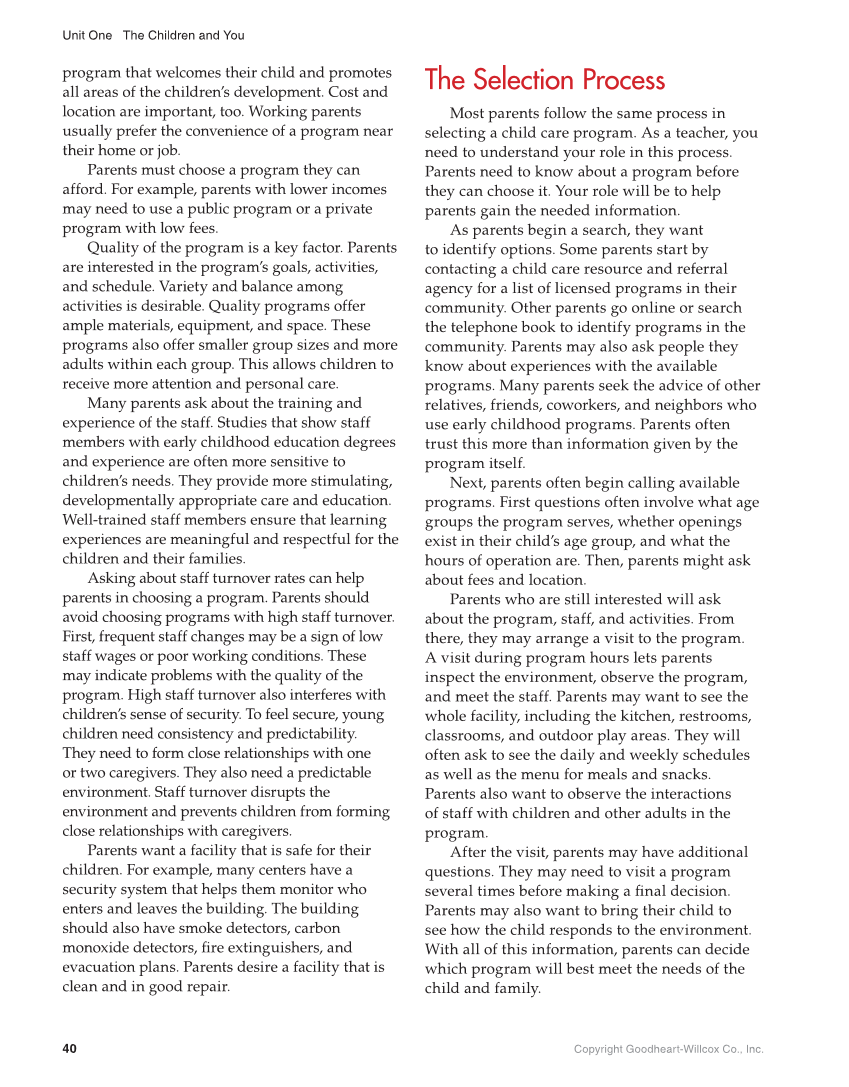Unit One The Children and You 40 Copyright Goodheart-Willcox Co., Inc. program that welcomes their child and promotes all areas of the children’s development. Cost and location are important, too. Working parents usually prefer the convenience of a program near their home or job. Parents must choose a program they can afford. For example, parents with lower incomes may need to use a public program or a private program with low fees. Quality of the program is a key factor. Parents are interested in the program’s goals, activities, and schedule. Variety and balance among activities is desirable. Quality programs offer ample materials, equipment, and space. These programs also offer smaller group sizes and more adults within each group. This allows children to receive more attention and personal care. Many parents ask about the training and experience of the staff. Studies that show staff members with early childhood education degrees and experience are often more sensitive to children’s needs. They provide more stimulating, developmentally appropriate care and education. Well-trained staff members ensure that learning experiences are meaningful and respectful for the children and their families. Asking about staff turnover rates can help parents in choosing a program. Parents should avoid choosing programs with high staff turnover. First, frequent staff changes may be a sign of low staff wages or poor working conditions. These may indicate problems with the quality of the program. High staff turnover also interferes with children’s sense of security. To feel secure, young children need consistency and predictability. They need to form close relationships with one or two caregivers. They also need a predictable environment. Staff turnover disrupts the environment and prevents children from forming close relationships with caregivers. Parents want a facility that is safe for their children. For example, many centers have a security system that helps them monitor who enters and leaves the building. The building should also have smoke detectors, carbon monoxide detectors, fi re extinguishers, and evacuation plans. Parents desire a facility that is clean and in good repair. The Selection Process Most parents follow the same process in selecting a child care program. As a teacher, you need to understand your role in this process. Parents need to know about a program before they can choose it. Your role will be to help parents gain the needed information. As parents begin a search, they want to identify options. Some parents start by contacting a child care resource and referral agency for a list of licensed programs in their community. Other parents go online or search the telephone book to identify programs in the community. Parents may also ask people they know about experiences with the available programs. Many parents seek the advice of other relatives, friends, coworkers, and neighbors who use early childhood programs. Parents often trust this more than information given by the program itself. Next, parents often begin calling available programs. First questions often involve what age groups the program serves, whether openings exist in their child’s age group, and what the hours of operation are. Then, parents might ask about fees and location. Parents who are still interested will ask about the program, staff, and activities. From there, they may arrange a visit to the program. A visit during program hours lets parents inspect the environment, observe the program, and meet the staff. Parents may want to see the whole facility, including the kitchen, restrooms, classrooms, and outdoor play areas. They will often ask to see the daily and weekly schedules as well as the menu for meals and snacks. Parents also want to observe the interactions of staff with children and other adults in the program. After the visit, parents may have additional questions. They may need to visit a program several times before making a fi nal decision. Parents may also want to bring their child to see how the child responds to the environment. With all of this information, parents can decide which program will best meet the needs of the child and family.
